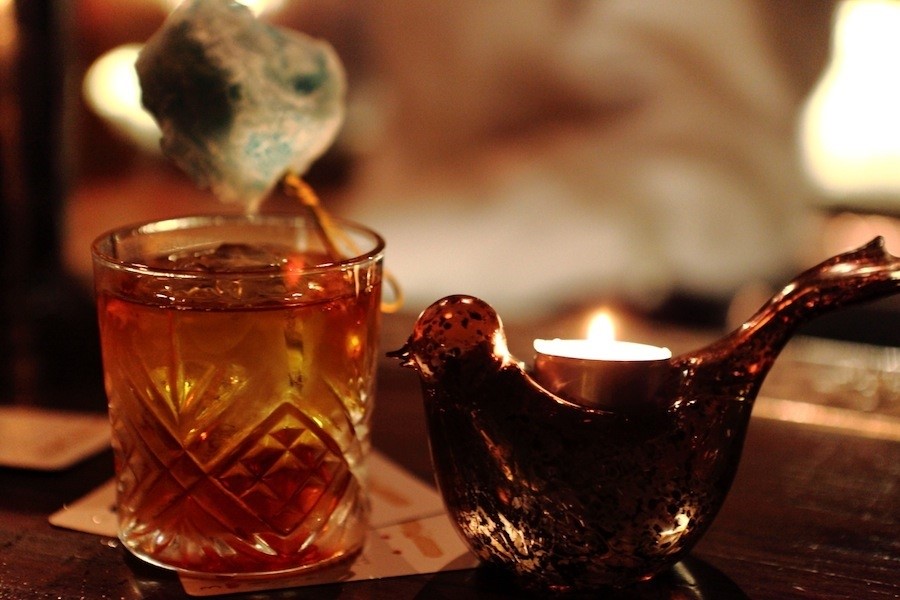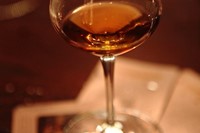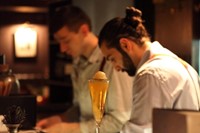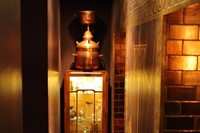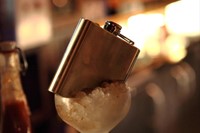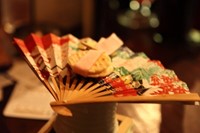Behind an nondescript wooden door off the Old Street roundabout, past a doorman and down a set of winding stairs, sits a warmly lit cocktail bar whose interior is influenced in parts by Art Deco design and traditional Americana...
Behind an nondescript wooden door off the Old Street roundabout, past a doorman and down a set of winding stairs, sits a warmly lit cocktail bar whose interior is influenced in parts by Art Deco design and traditional Americana; where the deep amber light, the smell of lavender and buttered popcorn, and the sounds of hot Jazz offer a welcome respite from the grey winter streets up above. Celebrating two years since their launch, the Nightjar in London has surpassed other self-proclaimed speakeasies to become the consummate cocktail bar.
Avoiding the over-sweet sensibility of traditional mixes, or the strict molecular style of contemporary mixology, the expertly executed cocktails at the Nightjar are composed with an eye to theatricality. Sophisticated kitsch (or, perhaps, kitschy sophistication) is of the essence here; and twists on traditional cocktails, as well as Nightjar signature drinks, come with no shortage of dry ice and other props – jasmine scented fans, flaming honeycomb, Turkish Delight, corn on the cob.
"The expertly executed cocktails at the Nightjar are composed with an eye to theatricality"
“Nightjars are quite interesting birds because they’re gregarious and vivacious at night,” the bar’s co-owner Edmund Weil tells us. “They come out and make a lot of noise, but during the day they’re completely camouflaged. That’s what we’re like: during the day you’d walk by this door anytime but at night it comes alive inside.”
When planning their first venture, Weil and his co-owner wife, Roisin Stimpson, envisioned a bar where they could hear the live music they loved – jazz, blues, swing, cabaret – in a copasetic setting. As it states on their Twitter account: “our inspiration comes from an age when live music was a customary part of a good night out, drinking was a connoisseur’s game, and hospitality was an art.” And it’s every bit true. The Night Jar’s seating-room-only policy means it never feels overcrowded, allowing their quick-witted, debonair, and highly talent bartenders to whip up complex concoctions at a clip. “It’s all about quality over quantity in every way,” says Weil.
The first cocktail to claim our attention is the Toronto. Quickly winning us over with a giant ‘garnish’ of smoked candyfloss, the mix of Woodford Reserve bourbon, roasted pecan maple syrup, Nightjar bitters, and Fernet Branca gives the drink a rich golden colour, while the taste is smooth with a welcome kick. Next is the Zazerac, made from Appleton Estate eight-year rum, pimento smoke, Peychaud’s bitters, La Clandestine absinthe, Perique tobacco liqueur, and chocolate bitters – all served in a cocoa pod ensconced in dry ice. Dramatic and refined, it combines the warmth of the tropics with the icy chill of the Arctic. The Queen Elizabeth also proves a lively drinking experience. Made from Noilly Prat dry vermouth, Benedictine, Grey Goose vodka, and salt-pickled lime juice aged under water (in a fish tank behind the bar, in fact), it is citrusy bitter, sharp and sweet, and served in a conch.
As well as launching their new cocktail menu for 2013, the latest addition to the Nightjar is a cabinet of vintage spirits and liqueurs, dating back to the 1800s. Weil is ecstatic about these finds, many from America. “Opening old bottles is like literally opening a time capsule,” he says with an aficionado’s enthusiasm. “You’re drinking something that might have been created in a completely different way than how it’s done now. Also, some of these drinks, once the bottle is done, that’s it.” While the liqueurs are available as mixers – there’s vintage vermouth and everything needed to make a Manhattan, for example – Weil recommends enjoying them straight. A suggestion we heartily take up when trying an American rye from 1863, which is impossibly smooth, spicy, and sends a wave of warmth across our chests; a taste of history. We also have our eye on some whiskey from the 1860s, and some mid-20th century Fernet Branca, and we'll be keeping tabs on any newcomers to the cabinet – something to look forward to over the long nights ahead.
Text by Ananda Pellerin
Ananda Pellerin is a London-based writer and editor, and Neil Wissink is a visual artist also based in London. Read more from The Hunger here, and contact The Hunger here.
